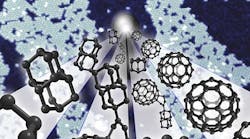Engineers at Stanford University combined two unconventional forms of carbon—buckminsterfullerene (also known as buckyballs) and diamondoids—and came up with a small electrical component: a rectifier. The new rectifier acts like a diode and only lets current flow in one direction. This new nanoscale electronic component could play a key role in shrinking electronic circuits down to the molecular scale and could lead to faster, less power-hungry devices.
Diamondoids, carbon bonded into cages in a similar way as diamonds but weighing only a billionth of a billionth of a carat, were found to emit electron beams and can be found in petroleum. Buckyballs, on theother hand, tend to “grab” electrons. They can be isolated from soot. Once joined into buckydiamondoids, researchers used a scanning tunneling microscope to measure current flow through them. They discovered current through the hybrid molecule from diamondoid to bucky ball was 50 times stronger than current flow in the opposite direction. Although this is not the first molecular rectifier ever made, it is the first made from just carbon and hydrogen. The research team’s next step is to determine if transistors can be made from the same simple ingredients.

